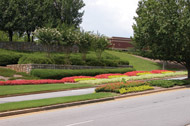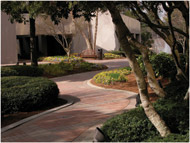|
FEATURE ARTICLE, MAY 2006
THE GRASS MIGHT BE GREENER ON THE OUTSIDE
How to determine if outsourcing commercial landscape maintenance makes sense for a property.
Debra Holder
 |
Gwinnett Progress Center is located on Highway 316 in Gwinnett County, Georgia.
|
|
Many property owners know a well-manicured landscape can increase rent, tenant retention and the value of a property but they remain skeptical of outsourcing landscape maintenance services to a professional provider — especially if the property maintenance team is doing a good job of keeping the grounds looking fresh. But the reality of is that 50 percent of commercial property owners outsource landscape maintenance.
How can you know if outsourcing landscape maintenance is the right decision for your property? Understand the truth behind common myths to make a more informed decision about how outsourcing can affect your bottom line.
The number one myth about outsourcing is that it is too expensive. For many firms, outsourcing is less expensive than the cost of performing landscape maintenance services in-house. Take for example, a team of two year-round maintenance workers who are responsible for maintaining your property. Let’s assume that the workers are paid an average wage of $10 per hour, 40 hours per week with overtime wages of $15 per hour. Four additional seasonal workers are brought in during the spring and fall at a rate of $8 per hour for an additional $1,280 – bringing your subtotal of gross annual wages to $74,080 per year. Add to this social security, employment taxes, health and disability insurance and workers compensation insurance for a total of $100,000.
Now consider additional employee expenses: management and supervisory costs by the property manager who spends 10 percent of his time managing the team ($80,000 per year/10 = $8,000), employee training and staff preparation costs ($5,000 per year) and liability insurance to protect from damages to personal property or individuals exposed to landscape operations in work areas ($10,000 per year) bringing additional employee expenses to a total of $23,000.
Next, let’s consider capital expenses to outfit the crew, including: a 4-wheel drive truck, trailer, mowers, other power tools, hand tools and personal safety equipment for a subtotal of $200,000 in capital expenses. Add annual equipment maintenance and repair expenses, including depreciation, for a subtotal of $70,000. Lastly, let’s look at landscape supplies and inventory — mulch, soil amendments, fertilizer and irrigation parts may add up to $10,000.
After adding up all of these expenses (and acknowledging equipment purchases are not a recurring annual expense), the total annual in-house cost of landscape maintenance operations can be more than $200,000 per year. After plugging in your own numbers, you’ll see that the prospect of hiring an outside team of landscape management professionals can often be of greater financial benefit.
 |
Peachtree Dunwoody Pavilion is located in Atlanta, Georgia.
|
|
The second major myth is that in-house staff know a property the best. It is easy to convince yourself that your current landscape maintenance staff knows your property best, but do they really know what’s best for your property? After all, they probably have stuck to the same planting; edging and tree care cycles for many years and may not be current on new fertilizer treatments, pesticides and/or other horticultural advances and environmental policies. One of the advantages of outsourcing landscape maintenance services is retaining a team of experts who care for hundreds of properties other than yours and can bring a wealth of experience to benefit your property.
Several of the nation’s top landscape maintenance providers have expert horticulturalists on staff. These horticulturalists stay current on the latest industry news and trends. If you are considering outsourcing landscape maintenance for your commercial property, it is worth speaking with potential service providers about their specific areas of expertise. The more information you share about your property — from what variety of trees and flowers you have planted to snow and ice removal strategies in the winter — the more detailed and accurate you can expect your response to be.
The final myth that needs to be dispelled is that full-time employees provide higher quality services than an outside company. Although it may sometimes feel like you have greater control over work performed by landscape maintenance employees, greater quality can sometimes be achieved by outsourcing to a landscape maintenance service provider. As a commercial property owner, evaluate the performance of in-house crews — does their work meet your quality expectations? Are the crews able to accomplish everything that needs to be done? During peak times such as snow removal, leaf removal, mulching, and spring turf surge growth, are crews able to keep up with the workload? Are you paying a lot of overtime or leaving work undone? Are there safety concerns regarding either the employees or site conditions?
Many of the nation’s top landscape maintenance service providers have quality control methodologies to ensure work meets expectations and is consistently duplicated across multiple properties. For example, some landscape maintenance providers will assign dedicated crew members to each task, so that work is performed more expediently. By continuously improving efficiencies, these landscape maintenance providers are better able to control costs and pass along the savings to customers in the form of a value-based contract price. Similarly, by dispatching a large crew to complete a job in 1 or 2 days instead of assigning one or two full-time employees to complete a job over a longer span of time, owners can be sure that projects are completed quickly with minimal tenant disruption and without having to pay unexpected overtime.
But where do you start when you are ready to consider outsourcing your property’s landscape maintenance needs? The first step to outsourcing is to prepare a detailed scope of work. The specifications must be very clear as to what work is to be included and the manner in which it is to be performed, in order to get comparable proposals from potential contractors. Most specifications now include requirements for the number of nationally or state-certified landscape and irrigation technicians who will manage the site.
When you are confident that the specifications clearly describe the work to be performed, issue a request for proposal (RFP). To compile a list of contractors to be included in the RFP process, ask for referrals from facility managers who supervise similar properties, observe the work of potential contractors who service properties in your area, or call trade associations such as PLANET (Professional Landscape Network).
In evaluating proposals from a national or regional landscape contractor, be sure to ask for references from similar properties in your area. If they do not own and operate service teams in your area, nany national companies will sub-contract the work and then bid the job out to a low-ball local contractor. Sub-contracting for specialty services is not always a bad thing. Just be sure you know who will be performing the actual work on your site, and that they meet your expectations regarding training, safety, professionalism and quality.
Debra Holder is director of industry relations for Brickman, a commercial landscape management firms operating in 23 states.
©2006 France Publications, Inc. Duplication
or reproduction of this article not permitted without authorization
from France Publications, Inc. For information on reprints
of this article contact Barbara
Sherer at (630) 554-6054.
|
